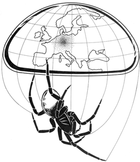 The Atlas of the European Arachnids is an unsystematic
but continuously updated collection of records (occurrences) of arachnid species (excluding mites)
in central Europe (while not excluding surrounding regions). This site continues the recording scheme
of the Arachnologische Gesellschaft, formerly maintained by Aloysius Staudt
(www.spiderling.de).
The Atlas of the European Arachnids is an unsystematic
but continuously updated collection of records (occurrences) of arachnid species (excluding mites)
in central Europe (while not excluding surrounding regions). This site continues the recording scheme
of the Arachnologische Gesellschaft, formerly maintained by Aloysius Staudt
(www.spiderling.de).
(These statistics are not updated in real-time for performance reasons. The actual numbers may be different. Last update: April 27, 2024, 07:45:07)
Citation: Arachnologische Gesellschaft (2024): Atlas of the European Arachnids, accessed at https://atlas.arages.de on {date of access}
Locations on maps are only displayed with a reduced precision when you are not logged in. Furthermore, the printing functions and advanced statistics are not available. Members of the Arachnologische Gesellschaft can log in at any time and use the Atlas without these restrictions after they have registered for the Members' Area of the main pages. For further information about an AraGes membership see here.
The taxonomy of Araneae on this site follows that of the World Spider Catalog in its latest version, that of the small orders (except Opiliones and Scorpiones) follows the World Arachnida Catalog. If nothing else is specified for a species from a species group, the species “s. str.” is meant.
All geographic coordinates use the WGS84 datum.
Records from the previous recording scheme are strongly reduced (usually only one record per decade, source, species and map grid). Furthermore, the record date is known only as a decade. For some sources the record date was corrected to be precise to a year. Only the latest records carry an exact date or date range spanning only a few days.
Locations from the former recording scheme were only known as a grid number of the topo-map series TK 25 (an “MTB”), i. e. they are only precise to an area of 10×6 minutes. Only the latest records are more precise. Records from outside of Germany are partially associated with a „pseudo”-MTB, i. e. they lie within a rectangular area with coordinates derived from the TK 25 grid number even though this sheet does not actually exist in the series. New records can be localized to any position in the world, also outside the TK 25 series area. Furthermore, some older records were subsequently localized more precisely.
The following grid systems are supported:
- Topographic map 1:25000 (Germany, TK 25)
- Czech Grid 1:25000 (Czech Republic, corresponds to TK 25)
- Slovak Grid 1:25000 (Slovakia, corresponds to TK 25)
- 10 km grid based on RGF93/Lambert-93 (France)
- 5 km grid based on Swiss coordinate system (CH1903, Switzerland)
- 5 km grid based on Luxembourg 1930/Gauß (Luxemburg)
Additional record data like collection method, sex, maturity, biotope type, etc. are typically only known for the newest records.
Biotopes are classfied according to the EUNIS (2012 revision).